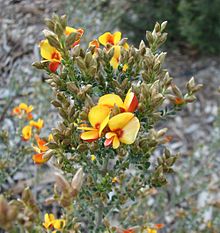- Mirbelia oxylobioides
-
Mirbelia oxylobioides 
Scientific classification Kingdom: Plantae (unranked): Angiosperms (unranked): Eudicots (unranked): Rosids Order: Fabales Family: Fabaceae Subfamily: Faboideae Tribe: Mirbelieae Genus: Mirbelia Species: M. oxylobioides Binomial name Mirbelia oxylobioides
F.Muell.[1]Mirbelia oxylobioides is an erect and spreading shrub in the family Fabaceae. It is endemic to Australia.
Contents
Description
The species grows to 3 metres in height and has stems covered with soft downy hairs.[2] The pointed leaves are narrow and ovate and arranged in pairs.[2] They are 2 to 10 mm long and 1 to 4 mm wide.[2] The pea flowers are orange-yellow with red markings and are usually produced between October and January in the species native range.[2] These are followed by down-covered brown pods.[2]
Taxonomy
The species was first formally described by botanist Ferdinand von Mueller in Fragmenta Phytographiae Australiae in 1861.[1]
Distribution
The species occurs in New South Wales, Victoria and Tasmania. In the latter state, it is only found in the Heathy Hills Nature Reserve near Elderslie where it is threatened by the effects of drought and the invasion of gorse. Consequently, it is classified as "vulnerable" under Tasmania's Threatened Species Protection Act.[2]
References
- ^ a b "Mirbelia oxylobioides". Australian Plant Name Index (APNI), IBIS database. Centre for Plant Biodiversity Research, Australian Government, Canberra. http://www.anbg.gov.au/cgi-bin/apni?TAXON_NAME=Mirbelia+oxylobioides. Retrieved 2009-09-15.
- ^ a b c d e f "Mirbelia oxylobioides". Threatened Flora of Tasmania. Department of Primary Industries, Parks, Water and Environment (Tasmania). http://www.dpipwe.tas.gov.au/inter.nsf/Attachments/SSKA-7597EV/$FILE/Mirbelia%20oxylobioides.pdf. Retrieved 2009-09-15.
Categories:- Faboideae
- Fabales of Australia
- Flora of New South Wales
- Flora of Victoria (Australia)
- Flora of Tasmania
- Faboideae stubs
- Australian rosid stubs
Wikimedia Foundation. 2010.
